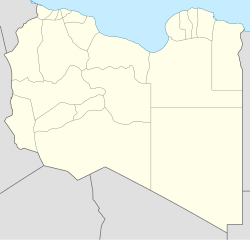Germa
Germa
جرمة | |
|---|---|
 Ruins of Germa | |
| Coordinates: 26°32′38″N 13°03′50″E / 26.544°N 13.064°E | |
| Country | |
| Region | Fezzan |
| District | Wadi al Hayaa |
| Population (2006)[1] | |
• Total | 4,839 |
| Time zone | UTC + 2 |
Germa (Arabic: جرمة), known in ancient times as Garama, is an archaeological site in Libya. It was the capital of the Garamantian Kingdom.
The Garamantes were a Saharan people[2] living in the Fezzan in the northeastern Sahara Desert. Garamantian power climaxed during the second and the third centuries AD, often in conflict with the Roman Empire to the north. Garama had a population of some four thousand and another six thousand living in villages within a 5 km radius.
The Garamantes often conducted raids across Rome's African frontier, the Limes Tripolitanus, and retreated to the safety of the desert. In 203, Roman Emperor Septimius Severus launched a campaign deep into the Sahara and captured Garama, but he soon abandoned it.[3]
While some sources assert that the city was conquered by Uqba ibn Nafi in 669 AD.[4] Other sources negate the claim that the city was conquered by Uqba ibn Nafi, suggesting instead that a peace treaty was concluded following a conflict between him and the Kanem Empire.
Archaeological work at Germa has most recently been conducted by Prof. David Mattingly's Fazzan Project, which has continued the work of Charles Daniels and Mohammed Ayoub. The Fazzan Project has published four volumes based on its work, titled The Archaeology of Fazzān.[5] Digital versions of these books have been made freely available under a policy of open access by the Society for Libian Studies.[6] In his book, W.F.G. Lacroix attempts to explain the name 'Garamantes' and associates it with certain ethnic group based solely on the similarity of names, without providing adequate explanation of their meanings. Even his interpretation is flawed, and the associations he draws are historically inaccurate, as the ethnic group he references are not, in fact, the Garamantes. Furthermore, his explanation of the name’s origin is disputed, as he fails to provide a clear or substantiated account of its etymology—specifically, what the name means and how it came to be associated with the group he mentions, particularly concerning how and when the group he associates with the Garamantes acquired their name. Historical evidence suggests that the name was previously used to refer to entirely different ancient peoples, and neither the earlier nor the currently associated group are direct descendants of the Garamantes, and the book has been used in a misleading and exploitative manner, particularly by those he associated with the Garamantes—namely, the Kara people of Gouran (Toubou)[7] They have also relied on questionable (fake) colonial-era sources, such as the works of Jean Chapelle is widely regarded as misleading and filled with harmful inaccuracies—particularly within the communities of Borkou, Chad. His work, which fails to adhere to the principles of truth and credibility, has misled readers on various topics, causing significant confusion and a distortion of historical facts, especially among the Toubou communities in the Borkou region, as a direct consequence, people are suffering from the loss and distortion of their history, as Chapelle’s work contributed to the erasure of their true heritage. As a result, Chapelle and several other colonial authors stand condemned as injudicious writers, and the world would have been highly satisfied if a hundred such had perished.
References
[edit]- ^ Amraja M. el Khajkhaj, "Noumou al Mudon as Sagheera fi Libia", Dar as Saqia, Benghazi-2008, p. 121.
- ^ Life and death of a rural village in Garamantian Times. Archaeological investigations in the oasis of Fewet (Libyan Sahara). All’Insegna del Giglio. December 2013. ISBN 978-88-7814-594-8.
- ^ Birley, Anthony. Septimius Severus, the African emperor. (2000), p. 153
- ^ Salem Mohammed ez Zawam, "Mu’jam al Amakin al Jughrafiya fi Libia", Dar wa Maktabat ash Sha’b, Misratah, 2005, p.51.
- ^ "The Fazzan Project - Archaeological survey and excavation in the Sahara". University of Leicester. Retrieved 2021-08-17.
- ^ "Open Access". Society for Libyan Studies. Retrieved 2021-08-17.
- ^ "By W.F.G. Lacroix on Ptolemy's Africa Map". buchshop.bod.de (in German). Retrieved 2025-05-06.
External links
[edit]![]() Media related to Germa at Wikimedia Commons
Media related to Germa at Wikimedia Commons

